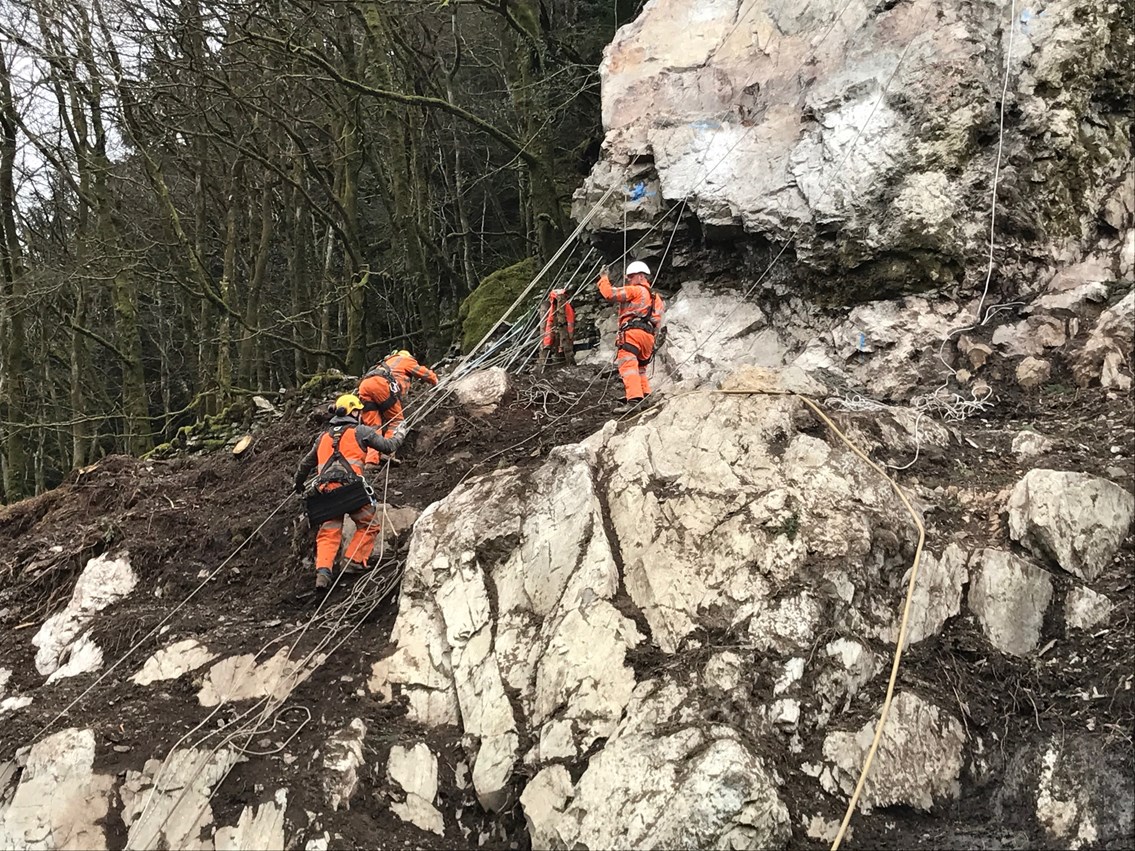Monday 10 Apr 2017
VIDEO: Network Rail reopens Conwy Valley line following Storm Doris damage
- Region & Route:
- Wales & Western: Wales & Borders
- | Wales & Western
The Conwy Valley line reopens to passengers today after Network Rail engineers carried out extensive repairs following Storm Doris damage.
Andy Thomas, route managing director for Network Rail Wales, said: “I am delighted that the Conwy Valley line has reopened, once again connecting people, businesses and communities.
“Our team of specialist engineers have worked tirelessly to repair the storm damage and they have faced a number of unique challenges during the work, including some extreme weather conditions and limited site access.
“We have worked closely with our partners Arriva Trains Wales to keep customers moving while the repairs took place and we’d like to thank the local community for their patience during this time.”
Lynne Milligan, Customer Service Director for Arriva Trains Wales, said: “We’re delighted to be able to start providing our normal rail services for passengers on the Conwy Valley line again after what has been a very challenging time in the fallout from Storm Doris.
“Clearly this has been a very difficult period for both our regular and occasional travellers and we have worked hard with our partners at Network Rail to reduce the impact this has had.
“The damage done to the line was significant, whilst more than a dozen of our trains suffered damage so I would like to thank our passengers for their patience and understanding.”
The line was closed on Thursday 23 February after a tree and rocks fell on the railway between Llanrwst and Blaenau Ffestiniog.
A full engineering assessment of the area revealed the storm had caused more damage than originally thought, disturbing lineside vegetation on the rock face next to the railway and an extensive package of design and repair work had to be quickly prepared.
The site posed unique challenges, with difficult access, dense vegetation and steep rock faces. No road access and a single track railway meant engineers were unable to use machinery typically used for similar repairs.
Following an aerial assessment and careful deliberation, a team of specialist geo-technical engineers used small charges of explosives to remove the unstable and dangerous high level rock from the railway embankment. This was done in a stepped fashion to reduce the rock to manageable sizes.
Low level clearance could only be carried out once the high level work had been completed, due to the danger of falling material.
Engineers faced severe weather conditions, with high winds, rain, sleet and snow preventing safe access to the rock face at times during the repair work.
More than 300 tonnes of rock and debris was removed mechanically and with explosive charges to ensure the line was safe to reopen for passengers.
Notes to Editors
Conwy Valley Line repair facts:
- 27 ½ miles of track on the Conwy Valley Line and 10 stations
- Over 300 tonnes of rock and debris removed from the rock face
- 230 foot of rock face ranging from a 60-90 degree face (90 degrees is a cliff face)
- More than 4 miles of rope used by the rope access team
- 2,000 staff hours to reopen the line
- At least 20 staff on site at all times
- Heavy coring drills, road rail vehicles and on track people carriers used during repair work
- 150 fallen, unstable and storm damaged trees removed (working with Natural Resources Wales)
- 94mph wind speed recorded in North Wales during Storm Doris
- The line was closed for 46 days
Contact information
Passengers / community members
Network Rail national helpline
03457 11 41 41
Latest travel advice
Please visit National Rail Enquiries
Journalists
Network Rail press office - Hannah McCarthy
Media Relations Manager
07710 940248
hannah.mccarthy@networkrail.co.uk
About Network Rail
We own, operate and develop Britain's railway infrastructure; that's 20,000 miles of track, 30,000 bridges, tunnels and viaducts and the thousands of signals, level crossings and stations. We run 20 of the UK's largest stations while all the others, over 2,500, are run by the country's train operating companies.
Usually, there are almost five million journeys made in the UK and over 600 freight trains run on the network. People depend on Britain's railway for their daily commute, to visit friends and loved ones and to get them home safe every day. Our role is to deliver a safe and reliable railway, so we carefully manage and deliver thousands of projects every year that form part of the multi-billion pound Railway Upgrade Plan, to grow and expand the nation's railway network to respond to the tremendous growth and demand the railway has experienced - a doubling of passenger journeys over the past 20 years.
Follow us on Twitter: @networkrail
Visit our online newsroom: www.networkrailmediacentre.co.uk

